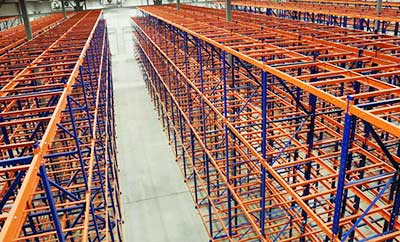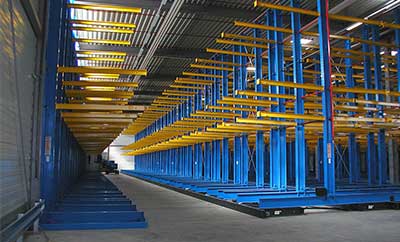
Standard Wide Aisle Pallet Racking
Standard Wide Aisle Pallet Racking is one of the most wildly used storage system

Pallet Shuttle System
Pallet Shuttle System is a semi-automatic compact system that uses an electric shuttle to load

Drive-In Pallet Racking
Drive-in Racking System is the most high-density storage solution that needs

Multi Tier Shelving System
Multi tier Shelving systems are custom designed to take advantage of unused vertical

Heavy Duty Cantilever
Heavy Duty Cantilever is suitable for storing beams, pipes, light bar stock

Mobile Shelving System
The mobile shelving system offers high-density storage requiring only one moving aisle

Standard Wide Aisle Pallet Racking
Standard Wide Aisle Pallet Racking is one of the most wildly used storage system...
Learn More
Pallet Shuttle System
Pallet Shuttle System is semi-automatic compact system that uses an electric...
Learn More
Drive-In Pallet Racking
Drive-in Racking System is the most high-density storage solution that needs...
Learn More
Multi Tier Shelving System
Multi tier Shelving systems are custom designed to take advantage...
Learn More
Mobile Shelving System
The mobile shelving system offers high-density storage requiring...
Learn MoreProducts & Services
Solution for your storage systems.

-

Pallet Racking
Standard Wide Aisle Pallet Racking, Very Narrow Aisle Pallet Racking (VNA), Mobile Pallet Racking, Pallet Shuttle System
-

Shelving
Standard Shelving System, Mobile Shelving System, Multi-Tier Shelving System, Narrow Aisle Shelving, Medium Span Shelvin
-

Cantilever
Heavy Duty Cantilever, Medium Duty Cantilever, Light Duty Cantilever, Mobile Cantilever, Roll-Rack Long Product Storage,
-

Work Space Optimization
Heavy Duty Cantilever, Medium Duty Cantilever, Light Duty Cantilever, Mobile Cantilever, Roll-Rack Long Product Storage,
SOLUTION FOR YOUR STORAGE SYSTEMS
We support you, right from your thought for storage system requirements, to the delivery and installation. Our custom design and built, based on your specific storage material, which is scientifically proposed with load calculation and material selection. We optimize your storage area to its maximum cubic volume, with advanced operational mechanism.
About MoreSTORAGE OPTIMIZATION
Storage optimized to the maximum potential area.
QUALITY COMMITMENT
Highest quality of material, design and fabrication.
BEST DELIVERY TIME
Boost your Forex trading experience with Quebex – the platform you can rely on!
Request a quote
Welcome to Milestone Storage Solutions
Milestone Storage Solutions, is a division of Milestone Arabia Trading LLC, established in 2010, is a pioneer in storage systems and equipment, serving a large number of reputed customers in UAE and exporting to various part of the world, in line with specific design and built projects as well as wholesale and retails supply.
Have any question or want a free estimate?
+971 (4) 258 1815
Our service provided areas
Scotla, Mastra, Lomosta, Twista

Projects Completed

Exports

Supply Capacity

Business Partners
ABOUT US
We are with you, right from your thought for storage requirements, to the delivery and installation. Our custom design and built, based on your specific storage material, which is scientifically proposed with load calculation and material selection. We optimize your storage area to its maximum cubic volume, with advanced operational mechanism.
QUICK LINKS
Service Provided
Contact Info
Address : Warehouse 4, Industrial Area 4, Behind Galadari Driving School, Al Qusais, Dubai, UAE
Phone : +971 4 2211 771
Phone : +971 4 354 7852
Email : [email protected]
Opening Hours : 9:00am to 6:00pm

